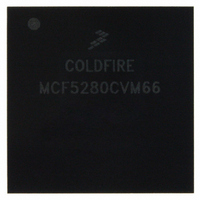MCF5280CVM66 Freescale Semiconductor, MCF5280CVM66 Datasheet - Page 567

MCF5280CVM66
Manufacturer Part Number
MCF5280CVM66
Description
IC MPU 32BIT COLDF 256-MAPBGA
Manufacturer
Freescale Semiconductor
Series
MCF528xr
Datasheet
1.MCF5216CVM66J.pdf
(766 pages)
Specifications of MCF5280CVM66
Core Processor
Coldfire V2
Core Size
32-Bit
Speed
66MHz
Connectivity
CAN, EBI/EMI, Ethernet, I²C, SPI, UART/USART
Peripherals
DMA, LVD, POR, PWM, WDT
Number Of I /o
142
Program Memory Type
ROMless
Ram Size
64K x 8
Voltage - Supply (vcc/vdd)
2.7 V ~ 3.6 V
Data Converters
A/D 8x10b
Oscillator Type
External
Operating Temperature
-40°C ~ 85°C
Package / Case
256-MAPBGA
Controller Family/series
ColdFire
No. Of I/o's
150
Program Memory Size
2KB
Ram Memory Size
64KB
Cpu Speed
66.67MHz
Embedded Interface Type
CAN, I2C, SPI, UART
No. Of Pwm Channels
8
Rohs Compliant
Yes
Lead Free Status / RoHS Status
Lead free / RoHS Compliant
Eeprom Size
-
Program Memory Size
-
Available stocks
Company
Part Number
Manufacturer
Quantity
Price
Company:
Part Number:
MCF5280CVM66
Manufacturer:
FREESCAL
Quantity:
151
Company:
Part Number:
MCF5280CVM66
Manufacturer:
Freescale Semiconductor
Quantity:
10 000
Company:
Part Number:
MCF5280CVM66J
Manufacturer:
Freescale Semiconductor
Quantity:
10 000
Company:
Part Number:
MCF5280CVM66L
Manufacturer:
FREESCAL
Quantity:
151
- Current page: 567 of 766
- Download datasheet (9Mb)
Queued Analog-to-Digital Converter (QADC)
Specifically, this means that while the QADC is operating, the data in the result registers can change from
one read to the next. Simply initiating a read of one result register will not prevent another from being
updated with a new conversion result.
Thus, to read any given number of result registers coherently, the queue or queues capable of modifying
these registers must be inactive. This can be guaranteed by system operating conditions (such as, known
completion of a software-initiated queue single-scan or no possibility of an externally triggered/gated
queue scan) or by simply disabling the queues (writing MQ1 and/or MQ2 to 0).
28.7.2
External Multiplexing
External multiplexer chips concentrate a number of analog signals onto a few QADC inputs. This is useful
for applications that need to convert more analog signals than the QADC converter can normally support.
External multiplexing also puts the multiplexed chip closer to the signal source. This minimizes the
number of analog signals that need to be shielded due to the proximity of noisy high speed digital signals
at the microcontroller chip.
For example, four 4-input multiplexer chips can be put at the connector where the analog signals first
arrive on the printed circuit board. As a result, only four analog signals need to be shielded from noise as
they approach the microcontroller chip, rather than having to protect 16 analog signals. However, external
multiplexer chips may introduce additional noise and errors if not properly utilized. Therefore, it is
necessary to maintain low “on” resistance (the impedance of an analog switch when active within a
multiplexed chip) and insert a low pass filter (R/C) on the input side of the multiplexed chip.
28.7.2.1 External Multiplexing Operation
The QADC can use from one to four external multiplexer chips to expand the number of analog signals
that may be converted. Up to 16 analog channels can be converted through external multiplexer selection.
The externally multiplexed channels are automatically selected from the channel field of the CCW, the
same as internally multiplexed channels. The QADC is configured for the externally multiplexed mode by
setting the MUX bit in control register 0 (QACR0).
Figure 28-18
shows the maximum configuration of four external multiplexer chips connected to the
QADC. The external multiplexer chips select one of four analog inputs and connect it to one analog output,
which becomes an input to the QADC. The QADC provides two multiplexed address signals, MA[1:0], to
select one of four inputs. These inputs are connected to all four external multiplexer chips. The analog
output of the four multiplexer chips are each connected to separate QADC inputs (ANW, ANX, ANY, and
ANZ) as shown in
Figure 28-18
MCF5282 and MCF5216 ColdFire Microcontroller User’s Manual, Rev. 3
Freescale Semiconductor
28-29
Related parts for MCF5280CVM66
Image
Part Number
Description
Manufacturer
Datasheet
Request
R
Part Number:
Description:
Manufacturer:
Freescale Semiconductor, Inc
Datasheet:
Part Number:
Description:
Manufacturer:
Freescale Semiconductor, Inc
Datasheet:
Part Number:
Description:
Manufacturer:
Freescale Semiconductor, Inc
Datasheet:
Part Number:
Description:
Manufacturer:
Freescale Semiconductor, Inc
Datasheet:
Part Number:
Description:
Manufacturer:
Freescale Semiconductor, Inc
Datasheet:
Part Number:
Description:
Manufacturer:
Freescale Semiconductor, Inc
Datasheet:
Part Number:
Description:
Manufacturer:
Freescale Semiconductor, Inc
Datasheet:
Part Number:
Description:
Manufacturer:
Freescale Semiconductor, Inc
Datasheet:
Part Number:
Description:
Manufacturer:
Freescale Semiconductor, Inc
Datasheet:
Part Number:
Description:
Manufacturer:
Freescale Semiconductor, Inc
Datasheet:
Part Number:
Description:
Manufacturer:
Freescale Semiconductor, Inc
Datasheet:
Part Number:
Description:
Manufacturer:
Freescale Semiconductor, Inc
Datasheet:
Part Number:
Description:
Manufacturer:
Freescale Semiconductor, Inc
Datasheet:
Part Number:
Description:
Manufacturer:
Freescale Semiconductor, Inc
Datasheet:
Part Number:
Description:
Manufacturer:
Freescale Semiconductor, Inc
Datasheet:











